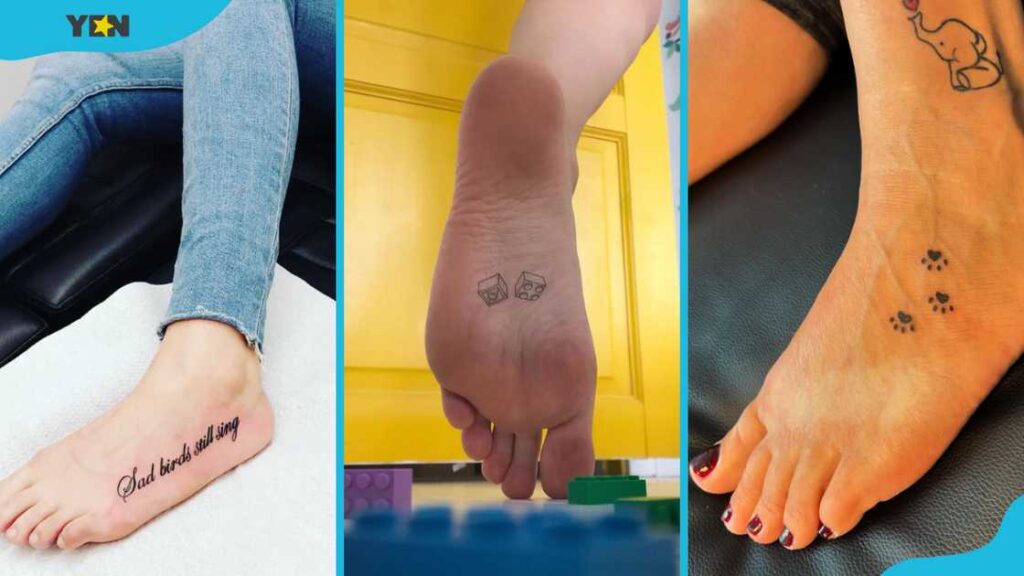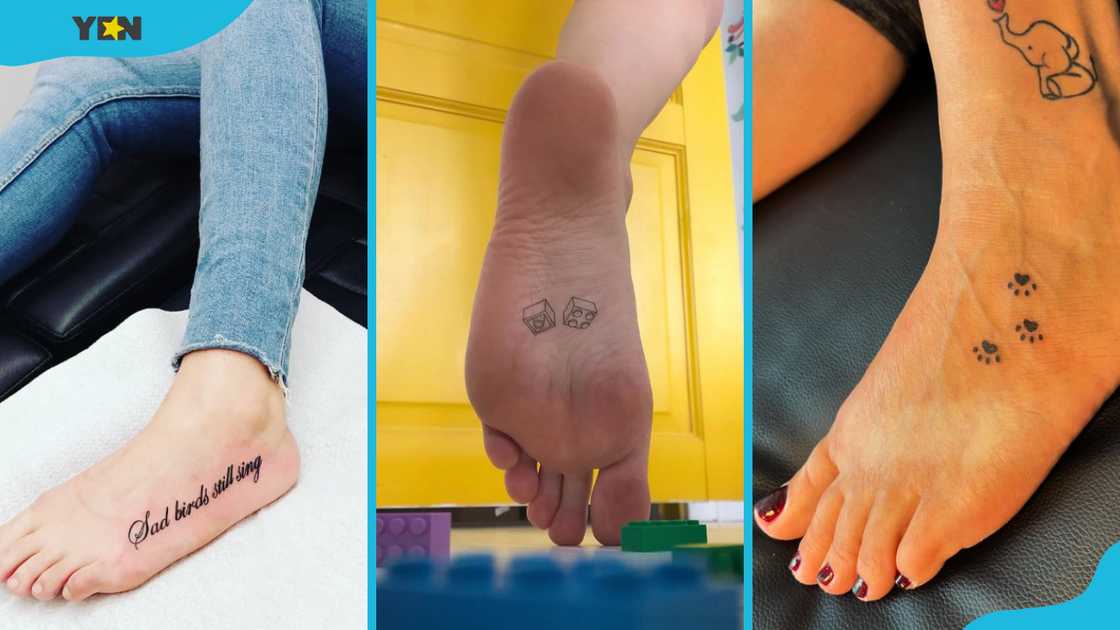
Small Foot Tattoos: Delicate Designs & Pain Considerations
Foot tattoos, particularly small foot tattoos, have surged in popularity in recent years. Their discreet placement allows for personal expression that can be easily concealed or proudly displayed. However, before committing to a small foot tattoo, it’s crucial to understand the design options, pain levels, aftercare requirements, and potential risks involved. This article provides a comprehensive overview of everything you need to know about getting a small foot tattoo.
The Allure of Small Foot Tattoos
The appeal of small foot tattoos lies in their subtlety and versatility. They offer a unique way to adorn the body without being overly conspicuous. This makes them an attractive option for individuals who may work in more conservative environments or simply prefer understated body art. Furthermore, the smaller size allows for intricate designs that can be easily accommodated on the limited surface area of the foot.
Popular Small Foot Tattoo Designs
The possibilities for small foot tattoo designs are virtually endless. Here are some of the most popular choices:
- Floral Designs: Delicate flowers, such as roses, lilies, or daisies, are a classic and feminine choice. They can be rendered in various styles, from minimalist outlines to vibrant, full-color depictions.
- Geometric Shapes: Simple geometric shapes, like triangles, circles, or squares, offer a modern and minimalist aesthetic. These designs can be customized to create unique and visually appealing patterns.
- Stars: Stars are a timeless symbol of hope and guidance. A cluster of small foot tattoos featuring stars can create a celestial effect.
- Animals: Small animal motifs, such as butterflies, birds, or paw prints, can represent personal qualities or connections to nature.
- Words and Quotes: Short words or meaningful quotes can be a powerful way to express personal beliefs or values. Consider using a delicate font to maintain the tattoo’s subtle aesthetic.
- Mandala Inspired: Intricate mandala designs, even in miniature, can be stunning on the foot. They represent wholeness and can be deeply symbolic.
- Tribal Patterns: Small sections of tribal patterns can add a touch of history and cultural significance.
Pain Considerations for Foot Tattoos
One of the most important factors to consider before getting a small foot tattoo is the potential pain involved. The foot is a particularly sensitive area due to the thin skin, numerous nerve endings, and proximity to bone. The level of pain experienced can vary depending on individual pain tolerance, the specific location on the foot, and the artist’s technique. Areas closer to the bone, such as the top of the foot and the ankle, tend to be more painful than areas with more muscle or fat. Many people describe the sensation as a sharp, burning pain.
To mitigate the pain, consider the following:
- Choose an Experienced Artist: An experienced artist will have honed their technique to minimize discomfort.
- Take Breaks: Don’t hesitate to ask for breaks during the tattooing process.
- Stay Hydrated: Drinking plenty of water can help improve your pain tolerance.
- Avoid Alcohol and Caffeine: These substances can increase sensitivity to pain.
- Consider Numbing Cream: Topical numbing creams can help reduce pain, but be sure to consult with your artist beforehand.
Aftercare for Small Foot Tattoos
Proper aftercare is crucial for ensuring the longevity and appearance of your small foot tattoo. The foot is particularly susceptible to infection due to its proximity to the ground and exposure to bacteria. Here are some essential aftercare guidelines:
- Keep the Tattoo Clean: Gently wash the tattoo with mild, fragrance-free soap and warm water two to three times a day.
- Apply a Thin Layer of Ointment: After washing, apply a thin layer of tattoo aftercare ointment or a fragrance-free moisturizer.
- Avoid Soaking the Tattoo: Refrain from swimming, bathing, or soaking the tattoo for at least two weeks.
- Wear Loose-Fitting Shoes and Socks: Tight shoes and socks can irritate the tattoo and increase the risk of infection. Opt for breathable materials like cotton.
- Protect the Tattoo from the Sun: Sun exposure can fade the tattoo and damage the skin. Apply a broad-spectrum sunscreen with an SPF of 30 or higher.
- Avoid Picking or Scratching: Itching is a normal part of the healing process, but avoid picking or scratching the tattoo. This can lead to infection and scarring.
- Stay Hydrated: Proper hydration aids in the healing process.
Potential Risks and Complications
While small foot tattoos are generally safe, there are potential risks and complications to be aware of:
- Infection: As with any tattoo, infection is a risk. Signs of infection include redness, swelling, pain, pus, and fever. Seek medical attention immediately if you suspect an infection.
- Allergic Reactions: Some individuals may be allergic to the tattoo ink. Allergic reactions can manifest as itching, rash, or hives.
- Scarring: Improper aftercare or individual healing tendencies can lead to scarring.
- Fading: Foot tattoos are prone to fading due to friction from shoes and socks. Regular touch-ups may be necessary to maintain their appearance.
- Migration: Ink migration, where the ink spreads beyond the intended design, can occur, although it’s less common with smaller tattoos.
Choosing the Right Tattoo Artist
Selecting a reputable and experienced tattoo artist is paramount. Look for an artist who:
- Has a Clean and Sterile Studio: The studio should adhere to strict hygiene standards to prevent infection.
- Uses Sterile Equipment: The artist should use disposable needles and sterilize all equipment properly.
- Has a Portfolio of Their Work: Review the artist’s portfolio to assess their skill and style.
- Is Licensed and Insured: Ensure the artist is licensed and insured to protect yourself in case of complications.
- Communicates Clearly: The artist should be willing to answer your questions and address your concerns.
Placement Considerations for Small Foot Tattoos
The placement of your small foot tattoo can significantly impact its appearance and longevity. Common placement areas include:
- Top of the Foot: This area is visible and allows for larger designs, but it can be more painful.
- Side of the Foot: This area is more discreet and less painful, but it may be prone to fading due to friction from shoes.
- Ankle: The ankle is a relatively less painful area and offers a good balance between visibility and concealment.
- Toes: Toe tattoos can be cute and playful, but they are also prone to fading.
- Sole of the Foot: This area is hidden and less painful, but tattoos on the sole of the foot tend to fade quickly and are not recommended.
Maintaining Your Small Foot Tattoo
To keep your small foot tattoo looking its best, consider the following maintenance tips:
- Moisturize Regularly: Keeping the skin hydrated will help prevent fading and cracking.
- Protect from the Sun: Sunscreen is essential for preventing fading and damage.
- Avoid Harsh Chemicals: Harsh soaps and chemicals can irritate the tattoo.
- Get Touch-Ups as Needed: Regular touch-ups can help maintain the tattoo’s vibrancy and definition.
Conclusion
Small foot tattoos are a beautiful and discreet way to express yourself. By carefully considering the design, pain levels, aftercare requirements, and potential risks, you can ensure a positive and lasting experience. Remember to choose a reputable artist, follow proper aftercare guidelines, and maintain your tattoo to keep it looking its best for years to come. With proper planning, your small foot tattoo can be a cherished piece of body art that you’ll be proud to show off (or keep hidden, if you prefer!).
Ultimately, getting a small foot tattoo is a personal decision. Weigh the pros and cons, do your research, and choose a design that resonates with you. With careful planning and execution, you can enjoy a beautiful and meaningful piece of body art that you’ll cherish for years to come. Consider browsing online tattoo galleries and consulting with different artists to find inspiration and ensure you’re making the right choice. Remember to prioritize safety and hygiene throughout the entire process. Happy tattooing!
[See also: Ankle Tattoo Designs for Women]
[See also: The Ultimate Guide to Tattoo Aftercare]
[See also: Pain Chart for Tattoos]

